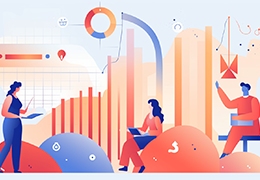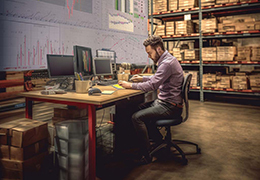As technology advances, the performance of artificial intelligence is often compared to that of human employees: Whose results are better? Who provides faster and more accurate answers? Who makes fewer mistakes? These questions are particularly relevant in retail, where innovative products are also being introduced. Consider, for example, sales forecasting. What's more effective—the seasoned expertise and even intuitive decisions of a specialist, or machine calculations? Alexander Gritsay, the CEO of Forecast NOW!, shares his thoughts on this matter.
When is Artificial Intelligence Ineffective?
One might assume that forecasts are always data-driven, and computers should analyze that data more efficiently than humans. However, there are situations and sectors where using AI for sales forecasting may not be appropriate. What are these cases?
— When Significant Factors Can't Be Digitalized
Take the fashion industry, for example. At its current stage of development, AI is unlikely to accurately forecast which trends will be popular in a new season and, consequently, which designs will be the most successful. Even with analyzing collections and identifying fashion trends, machines will likely struggle, as this information is hard to digitize for analytical purposes. While designers can use specialized software to assist them, it's ultimately their intuition, knowledge, and experience that enable them to create in-demand products.
However, as digitalization advances, AI could potentially forecast even fashion trends. For instance, it might be trained to track global tendencies, analyze social media posts from various influencers or brand ambassadors. Technologies already exist that gauge brand strength or even the general happiness and satisfaction level of a population based on tweets. These programs analyze the emotional tone and semantics of the text, but they are likely not very useful for retail at its current stage of development.
Areas involving trading and negotiations are also difficult to predict with AI. This is because final decisions in these sectors depend on human agreements, something a machine cannot forecast. Even in tenders with formally defined strict requirements, the winner isn't always who AI would have chosen.

On the other hand, if there's a transparent and automated trading platform where all transactions follow strict rules, software will outperform humans. It will analyze all parameters and make an optimal choice. Currently, retail is gradually incorporating platforms where trade is conducted by robot traders. However, the level of digitalization in the industry is still relatively low, which means forecasting is largely left in human hands.
— If the Company Doesn't Systematize Data
An intuitive approach works well where there is a lack of organized data. For example, if we're talking about a small range of products (say, about 10 SKUs), it's likely that a manager will keep this information mentally or record it in a way that makes sense to them, not a machine (i.e., in an unstructured manner). In such instances, human forecasting will likely perform better.
However, if you consider, for example, 100 SKUs, then companies might start employing automation tools—usually in addition to employee expertise. What specific processes are automated depends on the tools used and the type of goods. For wine, you might trust AI for demand forecasting and inventory calculations, but the final decision to place an order will most likely rest with humans. If it's a consistently selling everyday item, like milk, AI can not only forecast demand but can also automatically place the order.
— In Case of Emergencies or Unforeseen Situations
Let's say a company has a varied supply chain, sourcing some goods from China and some from local manufacturers. If a disruption occurs in one channel, quick action is required to find an alternative. In such cases, humans usually act more efficiently, while software can analyze the existing data to inform decision-making.
A case in point is the beginning of 2020. Even before the pandemic was declared, a sales manager who read news about the coronavirus and growing global concerns might have intuitively redirected supply chains toward local producers. As a result, the impact of border closures and strict lockdowns in other countries was minimized on the company.
Perhaps in the future, machines will be able to handle various unforeseen situations and analyze data from a wide range of sources to even predict events like a pandemic. However, these would undoubtedly be complex and costly algorithms that may not be accessible to most retailers.
What Are the Advantages of Artificial Intelligence?
Undoubtedly, AI excels at routine operations that follow established rules and involve structured, well-defined data. In these scenarios, artificial intelligence showcases its strengths: speed, the ability to analyze multiple data sources, and competency in handling complex formulas. Additionally, machines are not subject to what is often referred to as 'human factors.' They don't get tired, lose focus, or forget things. Of course, programs can make errors too, but their rate of miscalculation is generally lower.
Another advantage, or perhaps more accurately, a characteristic of software products is their consistent performance. Humans can produce either astounding results (often due to intuitive insights) or underperform. When it comes to the intuition of experienced professionals, it's a phenomenon that's hard to pin down. It encompasses tacit knowledge and experience, as well as an understanding of what is happening and what may happen in the future. However, intuition can be hit or miss.
Software products are also scalable. They can run on various computers, cater to different clients, and consistently deliver reliable results. In contrast, human expertise, which is largely the basis for intuition, can't be digitized or transferred from one professional to another. Interestingly, such transferability is being developed in fields like medical diagnosis. Systems in these domains take patient histories into account, construct decision trees, and forecast outcomes for other cases. Retail could also benefit from technology that takes into account not just previous sales data but the experience of individuals who have worked across different companies. However, even if such algorithms are developed, they are likely to be too expensive for the retail industry initially.
Why Do Human-AI Collaborations Sometimes Fail?
The optimal strategy for a company is not to choose between human expertise and computational algorithms but to leverage both—the intuition, knowledge, and skills of seasoned professionals, as well as the capabilities of artificial intelligence. For instance, in the launch of new products, a computer program can handle the information support system, providing various forecasting options based on input data, while staff members make the final decisions. However, there are times when employees resist the introduction of new tools and even actively sabotage the process.
For example, if a manager has been handling procurement for a long time, they may consider themselves an expert in that domain and believe that they have always made the right decisions. A store manager who is accustomed to seeing specific products in specific quantities may feel that this is how it should always be. In such cases, the transition to automation, like any other change, is often met with strong resistance. Moreover, employees may manipulate the algorithm's parameters to reflect their past results, even if those were inefficient.
As a result, many projects aimed at implementing automated forecasting fail because everything eventually reverts to average calculations in Excel. To avoid this, the needs of the employees must be considered when introducing automated tools. For example, retaining their "expert status" or the authority to make their own decisions can be valuable. And of course, some people simply do not trust complex systems, especially when it's unclear how specific results were derived.
There's a grain of truth in this. Verifying algorithms, like neural networks, can be quite challenging. For example, if a neural network is poorly trained or has never been trained at all, it might make completely random assumptions. You can only validate the accuracy of these forecasts through real-world implementation—by rolling it out and observing whether the predictions materialize. Essentially, with machine learning, the system develops a form of intuition similar to human intuition. And just like human intuition, it can sometimes be wrong. However, humans have common sense that they use to evaluate intuitive assumptions—for example, questioning the likelihood of demand suddenly increasing tenfold without any clear indicators. AI lacks such a "safety net," and will simply output the result.
That's why we decided to abandon machine learning technology in our project. Such a program could exceed the bounds of the subject area and make entirely incomprehensible predictions. Machine learning works well in areas where immediate verification is feasible, like facial recognition. However, in the realm of intangibles and future predictions, immediate verification of the solution's appropriateness isn't possible. We transitioned from forecasting through machine learning to simulation modeling, which inherently cannot make critical errors. It relies on past sales experience and models the future based on understandable principles and laws.
However, as experience with Chat GPT and numerous other neural networks shows, technology will continue to improve. AI's predictions will become more accurate, it will expand into new domains, and we'll be able to entrust it with an increasing number of tasks and calculations.



